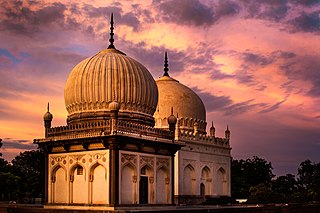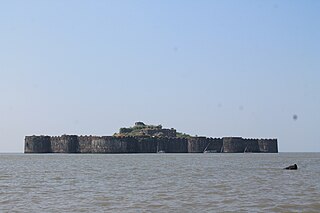
The Charminar is a monument located in Hyderabad, Telangana, India. Constructed in 1591, the landmark is a symbol of Hyderabad and officially incorporated in the emblem of Telangana. The Charminar's long history includes the existence of a mosque on its top floor for more than 425 years. While both historically and religiously significant, it is also known for its popular and busy local markets surrounding the structure, and has become one of the most frequented tourist attractions in Hyderabad. Charminar is also a site of numerous festival celebrations, such as Eid-ul-adha and Eid al-Fitr, as it is adjacent to the city's main mosque, the Makkah Masjid.

The Masjid-i-Jehan-Numa, commonly known as the Jama Masjid of Delhi, is one of the largest Sunni mosques in India.

The Qutub Shahi Tombs are located in the Ibrahim Bagh, close to the famous Golconda Fort in Hyderabad, India. They contain the tombs and mosques built by the various kings of the Qutub Shahi dynasty. The galleries of the smaller tombs are of a single storey while the larger ones are two-storied. In the centre of each tomb is a sarcophagus which overlies the actual burial vault in a crypt below. The domes were originally overlaid with blue and green tiles, of which only a few pieces now remain.

Amberpet is one of the oldest suburbs of Hyderabad, India. Amberpet lies adjacent to the famous Osmania University. It is also a Mandal in Hyderabad District. Its area stretches from Kachiguda to Ramanthapur in the East, and from 6 NO TO MALAKPET in the South. One of the oldest area of, Hyderabad, India.

Dar-ul-Shifa is a neighbourhood in the Old City of Hyderabad, India, named after the 16th-century hospital it once housed. The location was founded in AD 1591, more than 400 years ago, by Mohammed Quli Qutub Shah, the founder of Hyderabad city. Today it houses a large population of Shia Muslims and comes alive on the days of Muharram and Shia festivals. Most of the households have family members settled abroad, whose remittances increase the quality of life.
Edi Bazar is the oldest market place of Hyderabad, in Telangana state, India.

The Old City of Hyderabad is a walled city of Hyderabad, Telangana, India, located on the banks of the Musi River built by Qutb Shahi sultan Muhammed Quli Qutb Shah in 1591 AD. There used to be a wall surrounding the Old City, most of which is destroyed. Mubariz Khan, the Mughal governor of Deccan Subah, had fortified the city in 1712 and was completed by Nizam of Hyderabad.

Toli Masjid, also known as Damri Masjid, is a mosque in Hyderabad, in the Indian state of Telangana. It was constructed during the Qutb Shahi period and completed in 1671.
Hyderabad is the capital of the Indian state of Telangana. It is a historic city noted for its many monuments, temples, mosques and bazaars. A multitude of influences have shaped the character of the city in the last 400 years.

The history of Telangana, located on the high Deccan Plateau, includes its being ruled by the Satavahana Dynasty, the Kakatiya Dynasty (1083–1323), the Musunuri Nayaks (1325–1438), the Delhi Sultanate, the Bahmani Sultanate (1347–1512), Golconda Sultanate (1512–1687) and Asaf Jahi dynasty (1724–1950).
The Telangana Tourism Development Corporation is a state government agency which promotes Tourism in Telangana, a state in the Southern region of India. The retired Director General of Police Pervaram Ramulu is the appointed First chairman of Telangana State Tourism. Tourist attractions in Telangana include historical places, monuments, forts, waterfalls, forests and temples.

The Culture of Telangana in India has a cultural history of about 5,000 years. The region emerged as the foremost centre of culture in Indian subcontinent during the rule of Kakatiyas, the Qutb Shahis and Asaf Jahi dynasties—. The rulers patronage and interest for culinary, arts and culture transformed Telangana into a multi-cultural region where two different cultures coexist together, thus making Telangana the representative of the Deccan Plateau and its heritage with Warangal and Hyderabad being its epicenter. Hyderabadi cuisine and Kakatiya architecture both from Telangana, are on the list of UNESCO creative city of gastronomy and UNESCO World Heritage Site. The regions major cultural events celebrated are "Kakatiya Festival" and Deccan Festival along with religious festivals Bonalu, Bathukamma, Dasara, Ugadi, Sankranthi, Milad un Nabi and Ramadan.

The Deccan sultanates were five early modern kingdoms, namely Bijapur, Golkonda, Ahmadnagar, Bidar, and Berar, which ruled the Deccan Plateau for part of the 15th, and the majority of the 16th–17th centuries. Their architecture was a regional variant of Indo-Islamic architecture, and influenced by the styles of the Delhi Sultanate and later Mughal architecture, but sometimes also influenced from Persia and Central Asia. Hindu temple architecture in the same areas had very different styles.

The Musheerabad Masjid or Masjid e Kalan, is a mosque located in the Musheerabad locality of Hyderabad, India. The original portion was constructed in 1560 AD by Ibrahim Quli Qutb Shah, the fourth Sultan of the Qutb Shahi dynasty and is identical to the Hayat Bakshi Mosque located in Hayathnagar area of Hyderabad.

Kulsum Begum Masjid is a mosque in the Karwan locality of Hyderabad, India. It was built in the 17th century by Kulsum Begum, daughter of Sultan Muhammad Qutb Shah.

The architecture of Telangana dates back over two thousand years. The Indian state of Telangana is in the Deccan plateau, bordering the coastal plain of Andhra Pradesh. It has produced regional variants of wider styles of Indian architecture, both in Hindu temple architecture and Indo-Islamic architecture.

A distinct Indo-Islamic architecture style with local contribution is reflected in the historical buildings of Hyderabad, making it the first and "Best Heritage City of India" as of March 2012. The city houses many famous historical sites constructed during Qutb Shahi and Asaf Jahi period, including various mosques and palaces.
Qutb Shahi architecture is the distinct style of Indo-Islamic architecture developed during the reign of the Qutb Shahi dynasty, also known as the Golconda Sultanate.
















